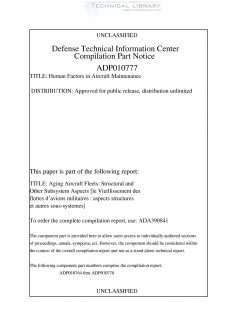DTIC-AD-P010777
- Version
- 234 Downloads
- 1.04 MB File Size
- 1 File Count
- March 5, 2017 Create Date
- March 5, 2017 Last Updated
Human Factors in Aircraft Maintenance

Abstract: Human error is cited as a major causal factor in most aviation mishaps, including the 15% - 20% that involve maintenance error. Errors can be described as active failures that lead directly to the incident, and latent failures whose presence provokes the active failure. Typical aviation maintenance errors are presented as examples and two approaches to human error reduction given: incident based and task analysis based. Each approach provides data on performance shaping factors, i.e. situation variables that affect the probability of error occurrences. Examples are given of interventions derived from analysis of incidents and from task analysis. 1. The Need for Human Factors in Maintenance: A sound aircraft inspection and maintenance system is important in order to provide the public with a continuing safe, reliable air transportation system (FAA, 1993). This system is a complex one with many interrelated human and machine components. Its linchpin, however, is the human. While research and development related to human factors in aviation has typically focused on the pilot and the cockpit working environment, there have been maintenance initiatives. Under the auspices of the National Plan for Aviation Human Factors, the FAA has recognized the importance of the role of the human in aircraft safety, focusing research on the aircraft inspector and the aircraft maintenance technician (AMT) (FAA, 1991, 1993). The classic term, ' 'pilot error" or "human error", is attributed to accidents or incidents over 75% of the time; however, a recent study in the United States found that 18% of all accidents indicate maintenance factors as a contributing agent (Phillips, 1994).
| File | Action |
|---|---|
| DTIC-AD-P010777 Human Factors in Aircraft Maintenance.pdf | Download |

Comment On This Post